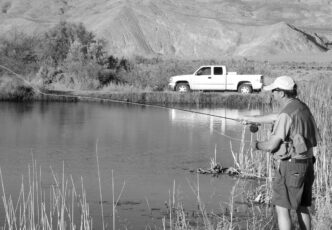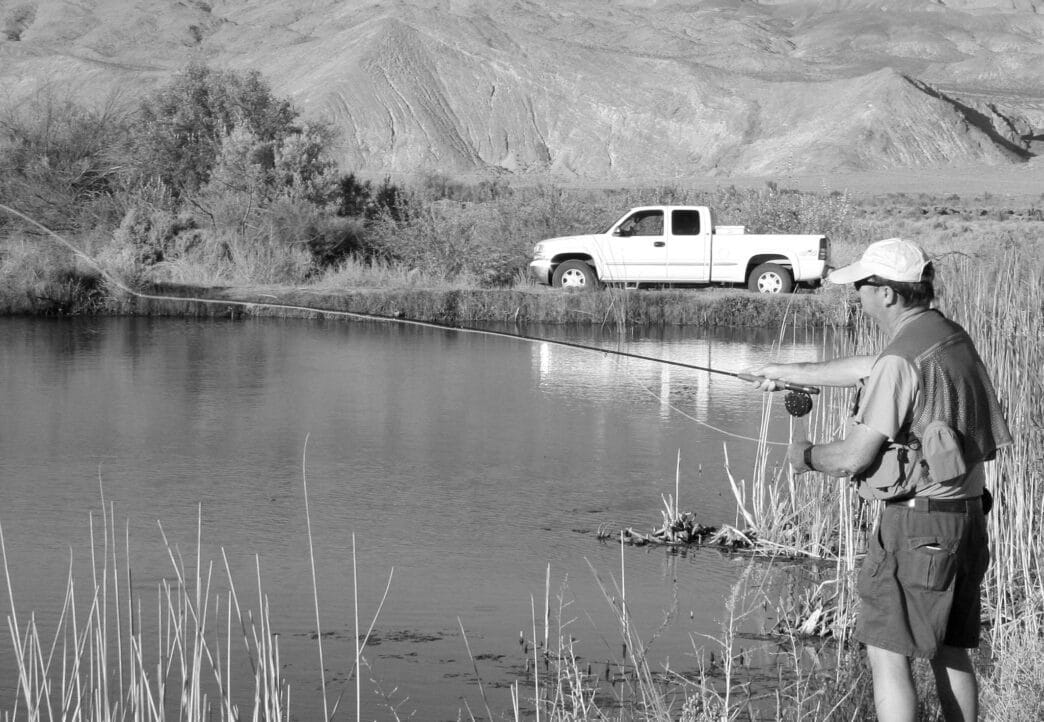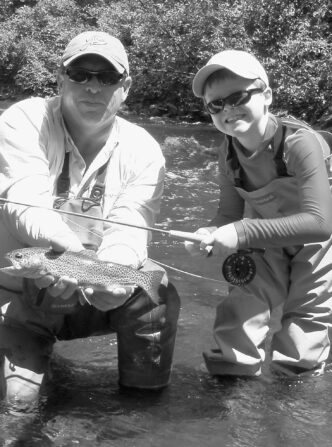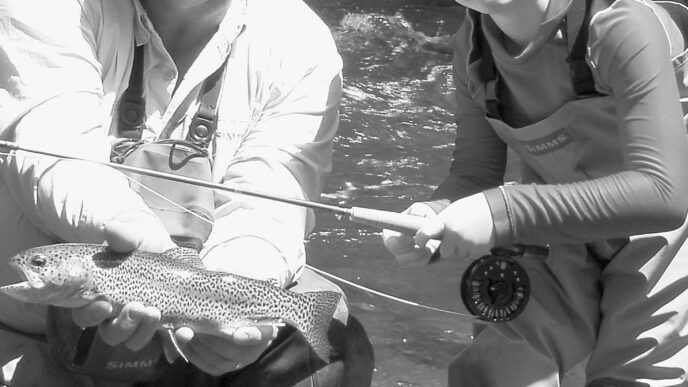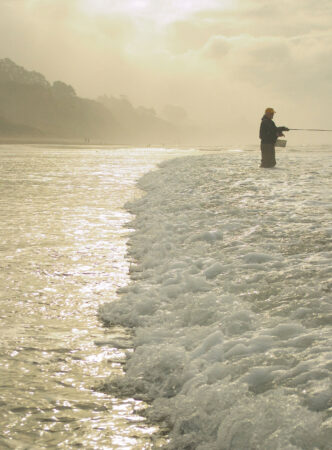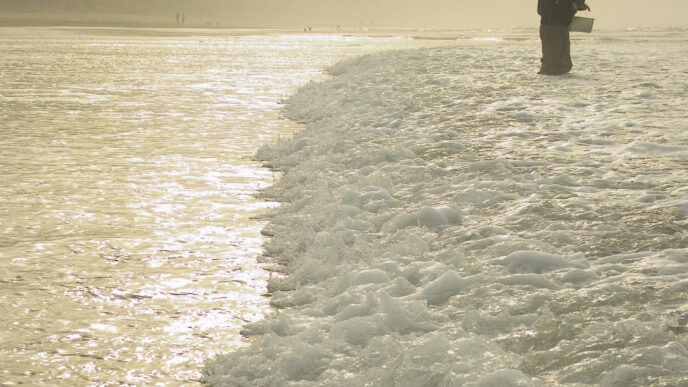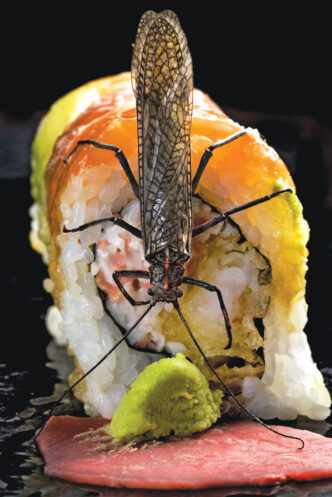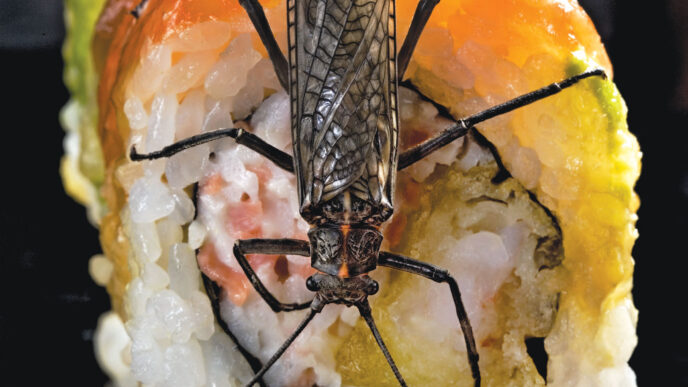As I write this column, it’s raining — not a hard rain, but a steady, gentle, soaking rain that will be good for both fish and other beasts, even if it keeps me indoors. Rainy days always remind me of a certain pond I used to fish. It wasn’t large — only a few acres of water in a local county park, but it just looked bassy, with lots of dense tules and big cottonwoods that leaned out over the water. The trees told visitors the pond was old, created to provide water for cattle, sheep, and a rancher’s vegetable garden many years before the park was built around it.
I first began to fish this pond in the late 1970s. My wife and I had just moved out to the desert town of Hesperia and were learning where the fish were located in this high-desert trio of communities, Victorville, Hesperia, and Apple Valley. Because this pond had been incorporated into a public park, it was among the first places we fished.
The angling itself wasn’t exceptional. The chance for solitude was. There weren’t a lot of people fishing it in those days, and on weekday spring and summer evenings, we often had the place all to ourselves. We were still working down in the Inland Empire then, commuting over the Cajon Pass twice each day.
We’d hit this pond two or three days a week after the nearly hour drive from work, arriving around five o’clock in the evening, with enough daylight left to get in at least a couple of hours of angling before the park ranger, anxious to close and get home for dinner, ran us out. In most cases, the fishing was fair, and every once in a while it would either peter out before sunset or switch on, and you’d catch a dozen fish in the last thirty minutes before darkness fell.
When the fishing was good, we’d stay as long as the ranger would let us, nodding our heads in agreement when he came around to chase us off, then making a few more casts until he came around for the second time. Or the third.
I know it’s ironic, but what I remember most were the rainy days, when the grass was wet and slick and the big cottonwood trees that crowded the bank dripped cold water down your neck as you fished. On rainy days, we would be the only visitors, and the angling was often better than when the sun was out.
In time, we found other ponds. One was on a back road out of town, and while it was a little busier, being a privately owned, pay-to-play lake, you could rig up a fly rod and fish to your heart’s content. This one was a better bluegill pond than a bass pond. Not that there weren’t bass there. There were. Not many, but a few really big, old bass that had evidently been caught a few times and couldn’t be fooled by our bass bugs. I did manage to hook one once. I had stayed home from work with a nasty cold, and after spending most of the morning going through a couple of boxes of Kleenex, decided that some country air would help my struggling sinuses. While wandering around the edge of the pond, I spotted this big bass finning quietly in a protected spot under a tree against the shore. I walked back to the car, rigged a 7-weight rod with a weight-forward line, and tied a large popper onto the tippet.
To my total astonishment, the big fish calmly took the popper on my third cast, rolled to the right, and simply snapped the bug off. It might have been my knot, but whatever the reason for the failure, I’ll remember forever watching more than 10 pounds of bass rising to take the bug in plain view of the angler who cast it. To say that it cleared my head in an instant would be understating the case. I fished for that bass the rest of the day and then on and off for several weeks, but never again saw it loitering under that tree.
My wife and I came across another interesting pond on the property of a big YMCA camp at the east end of Big Bear Lake. We had become involved with a group that held an event there every Memorial Day weekend, and the tiny impoundment — only an acre, perhaps a little bit more — caught my eye. Shallow and weedy, it didn’t hold bass, but instead was full of fat bluegills and sunfish.
We had gone up the mountain in my old Ford pickup truck, and because we had it, we also had the full complement of rods and reels I owned at the time. No one else in our group was interested in fishing the pond, and this gave us a wonderful sense of solitude. It was there that my wife caught the largest bluegill I’ve ever seen, before or since. It probably weighed three pounds or so. Holding it in your hand was like grasping a discus, the fish was that heavy and solid. One of the kids attending the event came over and asked us if we were going to keep it and seemed surprised when we let it go. I tried to explain to the boy that by putting it back, it would be there for us the next time. I don’t think he believed me.
There was also the pond at the local junior college. It was rimmed with grass, tranquil, except for the collection of coots and mallards that seem to be present on every pond in the Western states, and had a number of enormous trees that hung over the water. In the last decade of the twentieth century, the college was small and held only day classes. You could wander the grounds after classes had ended, and if you had a pass from the security office, you could fish.
This particular pond was frequented by several anglers who fished for its bass — mostly with live bait. I learned a lot by going to that college, or at least I learned a lot about fishing from bait anglers who had never attended a college class, but knew a thing or two about their sport.
One of the things I found interesting was how they fished live minnows and crayfish, which translated to more effective use of my collection of bass bugs. I was also delighted to note that they were, for the most part, catch-and-release anglers. And, yes, you can successfully release most bass caught on lures and even on live bait, if you are careful.
What do these several ponds have in common? Well, for one thing, they are all no longer fishable using fly gear now. One is bone dry, and given the county’s budget woes, it’s likely to stay that way. One was bought by the City of Hesperia and turned into a city recreation site where the staff gets paranoid if you try to cast a fly over the water. They are worried about some kid running behind a fly caster and getting hooked on the back cast. They see instant lawsuits looming.
The little mountain pond at the YMCA camp looks healthy enough, but it no longer has the huge panfish that used to swim there. A hard freeze to the bottom of the pond some years ago killed off the bluegills, and the camp’s managers never restocked it. The only thing the YMCA uses the lake for is canoeing, and I’ve never been able to talk the camp director into putting fish back in it.
The college grew, along with the communities it serves, and the relaxed atmosphere surrounding the pond gave way to nearly constant bustle from early morning to quite late at night and to a new generation of campus security guards who look at fishing as if it is a terrorist plot. End of privilege.
Now that the angling opportunities that these ponds offered is gone, I’ve had to find new places to fish. Nearby is Silverwood Lake, a large reservoir that is part of the mammoth system that transports water from the Sacramento–San Joaquin River Delta. It can offer good angling at times, but it is a big lake, over a thousand surface acres, and you never quite get that relaxed, homey feeling you often get while fishing a small pond.
There are small ponds here and there, but over the last few years, the owners of any wet spots large enough for a goldfish to call them home look at their waters with the perspective of a mercenary, seeing nothing other than the money that can be made with a pay-to-play fishery.
There are a few ponds left that are neither pay-to-play fisheries or overused and overfished city or county park ponds, but like all good things that come with the country life, they, too, are in danger of conversion or being singled out for a nice new parking lot for Walmart. I still have a couple of little ponds that I can fish more or less uninterrupted, and no, I’m not about to tell you where they are.
But the places where we once caught so many fish exist only in my memory, to be dragged out on rainy days to examine with affection. To be absolutely honest — a condition often a little lacking in a true angler — the fishing in these ponds was never quite as good as I recall it. It was, however, a lot better than no fishing at all. And at all of these ponds, the solitude was something that many of today’s anglers have never experienced.
I visited a pond the other day. It is one that has its entire eastern end choked by trees and brush drowned in shallows that hold sizeable bass and some enormous panfish. If it wasn’t in plain view of a local freeway and didn’t have a reputation for turning out multitudes of huge hatchery trout in the winter, it would be the perfect warmwater lake.
Instead, I found myself fishing almost elbow to elbow with a small horde of lure and bait anglers, listening to the incessant chatter of a host of portable radios and of only slightly fewer cell phone conversations. There was even one bait angler, rod held in a metal holder stuck in the ground, who spent his time playing games on an iPad. I left early.
The picture of a small pond nestled amid giant cottonwood trees that shimmer in the summer breeze remains strong in my memory, but this type of idyllic place to fish is definitely in short supply these days. The next generation of fly anglers may grow up without knowing the feel of a relaxed day of fishing a pond. And that’s not good.



